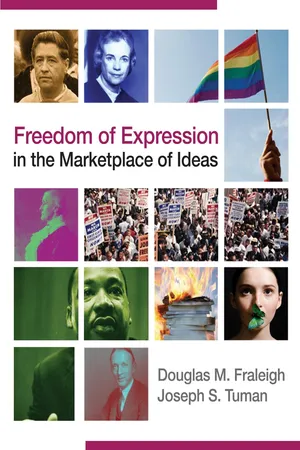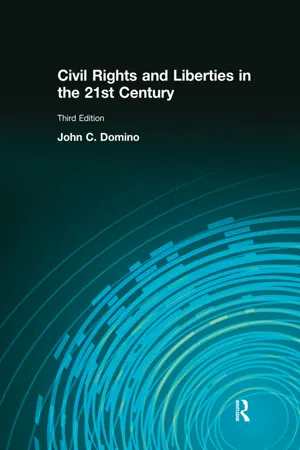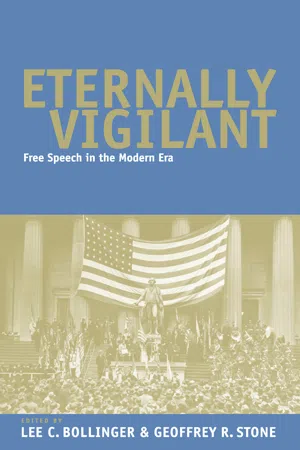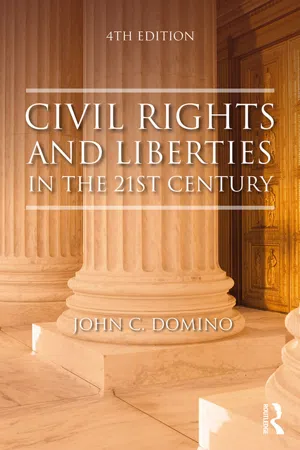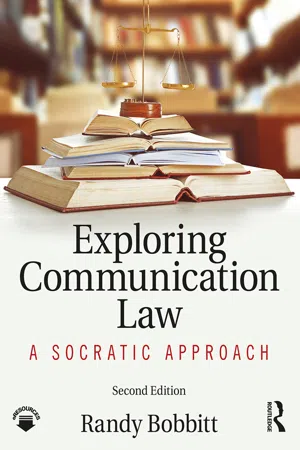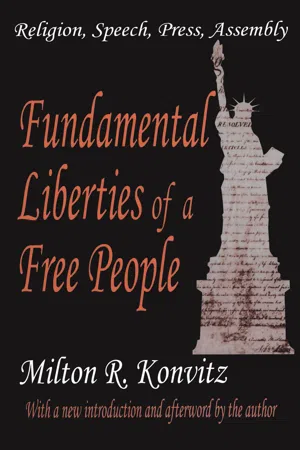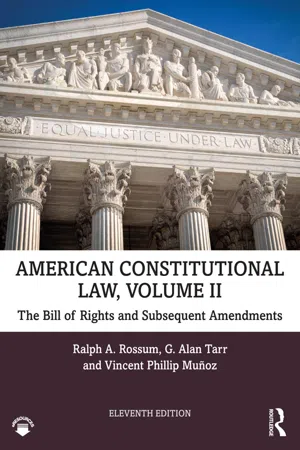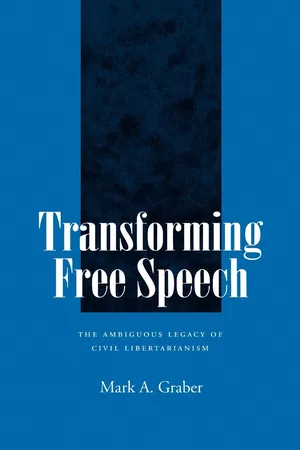Politics & International Relations
Schenck v. United States
"Schenck v. United States" was a landmark Supreme Court case in 1919 that established the "clear and present danger" test for determining when a state could constitutionally limit an individual's free speech rights under the First Amendment. The case involved Charles Schenck, who was convicted for distributing anti-draft leaflets during World War I. The decision set a precedent for balancing national security concerns with free speech rights.
Written by Perlego with AI-assistance
Related key terms
Related key terms
1 of 4
Related key terms
1 of 3
10 Key excerpts on "Schenck v. United States"
- Douglas Fraleigh, Joseph S. Tuman(Authors)
- 2010(Publication Date)
- SAGE Publications, Inc(Publisher)
1. What communication by the defendant led to his or her conviction? Charles Schenck, General Secretary of the Socialist Party in the United States, had prepared a leaflet for distribution to men who had been drafted. The leaflet argued that the draft was unconstitutional and encouraged draftees “not to submit to intimidation.” Schenck was convicted for violating the Espionage Act.2. What test did the Court use to decide if the defendant’s conviction was constitutional, and what reasoning did the Court use to justify this test? The Court announced the “clear and present danger” test in Schenck. This test allows speech to be punished “when the words are used in such circumstances and are of such a nature as to create a clear and present danger that they will bring about the substantive evils that Congress has a right to prevent.” The Court reasoned that free speech rights are not absolute because, after all, freedom of speech would not protect a man who falsely shouted “Fire!” in a theatre and caused a panic.3. How did the Court apply the test to the defendant’s communication to decide if the defendant’s free speech rights were violated? The Court held that Schenck’s speech could be punished because Schenck intended to obstruct the recruiting service and because his leaflets “tended” to cause such an obstruction. The Court did not require the government to prove that Schenck actually caused a disruption, reasoning that success (in impeding recruiting for the military) is not required before Schenck’s speech can be punished as a crime.More Defeats for Free SpeechThe Court decided two more Espionage Act cases one week after Schenck. These cases did not analyze whether the defendants’ speech created a clear or present danger to the government’s military recruiting efforts. To uphold the defendants’ convictions, using Schenck as a precedent, the Court required only that the communicators’ words tended to cause harm. Thus, the clear and present danger test used by the Court could more accurately be called a “bad tendency” rule.5- eBook - ePub
- John C Domino(Author)
- 2017(Publication Date)
- Routledge(Publisher)
We admit that in many places and in ordinary times the defendants in saying all that was said in the circular would have been within their constitutional rights. But the character of every act depends upon the circumstances in which it is done. Aikens v. Wisconsin, 195 U.S. 194 [(1904)]. The most stringent protection of free speech would not protect a man from falsely shouting fire in a theatre and causing panic. It does not even protect a man from an injunction against uttering words that may have all of the effect of force.The question in every case is whether the words used are used in such circumstances and are of such a nature as to create a clear and present danger that they will bring about substantive evils that Congress has a right to prevent. It is a question of proximity and degree. When a nation is at war many things that might be said in time of peace are such a hindrance to its effort that their utterance will not be endured so long as men fight and that no court should regard them as protected by any constitutional right.Thus, the clear and present danger doctrine that emerged from Schenck was used by the Court to determine the conditions under which the government may suppress political expression. Schenck is also significant because it provides insights into the Court’s early view of the scope of protection afforded by the First Amendment. Holmes quickly disavowed the notion that the First Amendment is absolute, particularly when speech is closely connected to some illegal act, such as “falsely shouting fire in a theater and causing panic” or advocating the obstruction of a legitimate governmental interest. However, before speech can be restricted, the government must look at the circumstances in which the words are spoken and the nature of the words to be suppressed.May the clear and present danger test be invoked even if the government has no proof of dangerous action or conduct? - eBook - ePub
Eternally Vigilant
Free Speech in the Modern Era
- Lee C. Bollinger, Geoffrey R. Stone, Lee C. Bollinger, Geoffrey R. Stone(Authors)
- 2018(Publication Date)
- University of Chicago Press(Publisher)
The “clear and present danger” test has come to signify considerable protection for speech and writing, but, prior to Schenck, the Supreme Court had not definitely established that the First Amendment forbids anything other than prior restraints—for example, licensing of who may write a book or make a speech. State courts typically had said that speech with merely a “bad tendency” to cause harm could be punished, thus affording state legislatures wide latitude to punish what they chose. 9 In Supreme Court cases following Schenck, most justices granted legislatures similarly broad scope to punish speech. 10 Since these justices joined the Schenck opinion, they obviously did not assume that it gave much more protection to speech and writing than did the bad tendency test. A second and related explanation of the opinion involves Holmes’s own position, about which there are two distinct views. One is that Holmes himself, right from the start, conceived “clear and present danger” as a standard that would protect speech, but that he cleverly wrote an opinion other justices could join. The second view is that Holmes’s own position developed over time, that when Schenck was decided he had not yet come to the conviction that speech and press should receive stringent protection. Two pieces of evidence support the second view. One is the way Holmes voted in Schenck and its two companion cases. 11 Someone who believed in strong protection of speech probably would not have voted to uphold all three convictions. Although Holmes may possibly have voted against his own convictions in order to write majority opinions that would preserve some protection of speech, justices usually vote according to how they think a case should come out - eBook - ePub
- John C. Domino(Author)
- 2018(Publication Date)
- Routledge(Publisher)
But the character of every act depends upon the circumstances in which it is done. Aikens v. Wisconsin, 195 U.S. 194 [(1904)]. The most stringent protection of free speech would not protect a man from falsely shouting fire in a theatre and causing panic. It does not even protect a man from an injunction against uttering words that may have all of the effect of force. The question in every case is whether the words used are used in such circumstances and are of such a nature as to create a clear and present danger that they will bring about substantive evils that Congress has a right to prevent. It is a question of proximity and degree. When a nation is at war many things that might be said in time of peace are such a hindrance to its effort that their utterance will not be endured so long as men fight and that no court should regard them as protected by any constitutional right. Thus, the clear and present danger doctrine that emerged from Schenck was used by the Court to determine the conditions under which the government may suppress political expression. Schenck is also significant because it provides insights into the Court’s early view of the scope of protection afforded by the First Amendment. Holmes quickly disavowed the notion that the First Amendment is absolute, particularly when speech is closely connected to some illegal act, such as “falsely shouting fire in a theater and causing panic” or advocating the obstruction of a legitimate governmental interest. However, before speech can be restricted, the government must look at the circumstances in which the words are spoken and the nature of the words to be suppressed. Under Schenck may the clear and present danger test be invoked even if the government has no proof of dangerous action or conduct? The answer is a definite yes. Speech can be restricted if evidence shows that the intent of the speech is to bring about a substantive evil or an illegal action - eBook - ePub
Exploring Communication Law
A Socratic Approach
- Randy Bobbitt(Author)
- 2017(Publication Date)
- Routledge(Publisher)
2 Because of its potential to be used to limit legitimate criticism of the government, the bad tendency test is no longer applied.Clear and Present Danger TestAs a result of a 1917 law called the Espionage Act (discussed later in this chapter), the Supreme Court developed the clear and present danger test, which established a higher burden of proof for restricting speech. Under this test, political speech must do more than create a bad tendency; it must present a “clear and present danger,” that is, a person’s speech must create a “high likelihood of harm,” such as that which motivates the audience to carry out violent acts. The clear and present danger test was first applied in 1919 and was commonly applied in free speech cases up to and including the 1950s and 1960s, even though it was last successfully used to limit speech in 1951.In two 1919 cases set against the backdrop of World War I—Schenck v. United States and Abrams v. United States—the government prosecuted men distributing leaflets opposing American involvement in the war and expressing other anti-establishment sentiments. In both cases, lower courts had convicted the men of violating the Espionage Act and the Supreme Court upheld the convictions. In Schenck, Justice Oliver Wendell Holmes coined the term “clear and present danger” and wrote that “even the most stringent protection of free speech would not protect a man who falsely shouts fire in a crowded theatre.”3 He further argued that criticisms of the government or the military that might be considered harmless during peacetime should not be tolerated during times of war.4 - eBook - ePub
Fundamental Liberties of a Free People
Religion, Speech, Press, Assembly
- Milton Konvitz(Author)
- 2018(Publication Date)
- Routledge(Publisher)
What Holmes said here in effect was this: Congress may enact a law under the terms of which a speech or a publication may constitute a criminal offense even in the absence of proof that it in fact brought about a substantive evil. The words themselves may constitute a substantive evil. But whether or not they do will depend on the surrounding circumstances. The words will be punishable if they are uttered or published under such circumstances that they create a clear and present danger that they will cause the evil that Congress has a right to prevent. In other words, a speech may by itself be a crime just as an attempt may by itself be a crime. It makes a difference whether a speech is made in a time of excitement and stress, or whether it is made when people are composed and relaxed; for “the degree of apprehension felt” is important. When slavery was in existence, as Holmes pointed out, a slave who ran after a white woman, though he desisted before he caught her, was convicted of an attempt to commit rape; so, too, in a time of war, the degree of apprehension of danger is greater than in a time of peace, and, therefore, words may be more greatly feared—they come close to the line where the Court may say that they constitute a clear and present danger; for, “when a nation is at war many things that might be said in time of peace are such a hindrance to its effort that their utterance will not be endured so long as men fight, and that no court could regard them as protected by any constitutional right.”It must be noted that the defendants in the Schenck case were convicted, and that the Supreme Court unanimously affirmed the judgments: the clear and present danger doctrine was used to support a denial of free speech. With rare exception, this is the way the doctrine has been used by the Court. No federal statute has ever been invalidated by the doctrine.A week after the decision in the Schenck case came the Court’s decision in the Frohwerk case, in which again the judgment of conviction was affirmed by a unanimous Court, with Justice Holmes writing the opinion.9 Frohwerk was indicted for conspiracy with another person in the preparation and circulation of twelve articles in a German-language newspaper in Missouri, by which he attempted to cause disloyalty, mutiny, and refusal of duty in the armed forces. Examining the articles, Justice Holmes found them similar to those in the Schenck - eBook - ePub
American Constitutional Law, Volume II
The Bill of Rights and Subsequent Amendments
- Ralph Rossum, Alan Tarr, Vincent Phillip Munoz(Authors)
- 2019(Publication Date)
- Routledge(Publisher)
The wisdom of the assumptions underlying the legislation and prosecution is another matter. Civil liberties draw at best only limited strength from legal guaranties. Preoccupation by our people with the constitutionality, instead of with the wisdom, of legislation or of executive action is preoccupation with a false value. Focusing attention on constitutionality tends to make constitutionality synonymous with wisdom. When legislation touches freedom of thought and freedom of speech, such a tendency is a formidable enemy of the free spirit. Much that should be rejected as illiberal, because repressive and envenoming, may well be not unconstitutional. The ultimate reliance for the deepest needs of civilization must be found outside their vindication in courts of law.JUSTICE JACKSON, concurring.The “clear and present danger” test was an innovation by Mr. Justice Holmes in the Schenck [v. United States (1919)] case, reiterated and refined by him and Mr. Justice Brandeis in later cases, all arising before the era of World War II that revealed the subtlety and efficacy of modernized revolutionary techniques used by totalitarian parties. In those cases, they were faced with convictions under so-called criminal syndicalism statutes aimed at anarchists but which, loosely construed, had been applied to punish socialism, pacifism, and left-wing ideologies, the charges often resting on farfetched inferences which, if true, would establish only technical or trivial violations. They proposed “clear and present danger” as a test for the sufficiency of evidence in particular cases. I would save it, unmodified, for application as a “rule of reason” in the kind of case for which it was devised.But its recent expansion has extended, in particular to Communists, unprecedented immunities. Unless we are to hold our Government captive in a judge-made verbal trap, we must approach the problem of a well-organized, nation-wide conspiracy, such as I have described, as realistically as our predecessors faced the trivialities that were being prosecuted until they were checked with a rule of reason. I think reason is lacking for applying that test to this case. - eBook - ePub
Transforming Free Speech
The Ambiguous Legacy of Civil Libertarianism
- Mark A. Graber(Author)
- 2023(Publication Date)
- University of California Press(Publisher)
123 These were just the sort of interests that progressive scholars like Schofield agreed warranted limiting expression rights. At least, this was the position taken by Justice Oliver Wendell Holmes, Jr., the jurist who most inspired sociological jurisprudence.The Myth of HolmesOn March 3,1919, the Supreme Court handed down its first major decision on the constitutional meaning of free speech. In Schenck v. United States, the justices unanimously held that the Espionage Act of 1917 was constitutional and that there were no valid First Amendment objections to the conviction of several socialists who had passed out leaflets protesting the draft. In his unanimous opinion, Justice Holmes declared that the Constitution did not protect words that might “cause a clear and present danger” of “substantive evils that Congress has a right to prevent.”124The repressive implications of Schenck were confirmed a week later when the justices handed down their decision in Debs v. United States.125In that case, a united court held that speakers could be constitutionally punished under the Espionage Act for asserting personal opposition to the war and approving the actions of persons “who had been convicted of aiding and abetting another in failing to register for the draft.” Justice Holmes again wrote for the Court: He declared that a jury could have found these sentiments had a “reasonable tendency and reasonably probable effect to obstruct the recruiting service.”126Chafee claimed that those “decisions … came as a great shock to forward looking men and women”; moreover, “they were especially grieved that the opinions … were written by the Justice who for their eyes had long taken heroic dimension.”127Yet American libertarians had no reason for surprise. Holmes had always been the leading authority for the narrowest interpretations of the constitutional meaning of free speech. He wrote the Court’s opinion in Fox v. Washington, which held that states Could punish advocacy of nudism. In other cases, Holmes rejected the good faith defense in libel suits, insisted that persons had no right to speak on public property, and suggested that the First Amendment merely rendered constitutional Blackstone’s rule of no prior restraint.128Furthermore, no progressive jurist had developed a broad constitutional defense of expression rights that was consistent with Holmes’s dissent in Lochner v. New York, a dissent that claimed “the word liberty in the Fourteenth Amendment is perverted when it is held to prevent the natural outcome of a dominant opinion.”129 - eBook - ePub
American Constitutional Law 8E, 2-VOL SET
2-VOLUME SET
- Ralph A. Rossum(Author)
- 0(Publication Date)
- Routledge(Publisher)
The wisdom of the assumptions underlying the legislation and prosecution is another matter. . . . Civil liberties draw at best only limited strength from legal guaranties. Preoccupation by our people with the constitutionality, instead of with the wisdom, of legislation or of executive action is preoccupation with a false value. . . . Focusing attention on constitutionality tends to make constitutionality synonymous with wisdom. When legislation touches freedom of thought and freedom of speech, such a tendency is a formidable enemy of the free spirit. Much that should be rejected as illiberal, because repressive and envenoming, may well be not unconstitutional. The ultimate reliance for the deepest needs of civilization must be found outside their vindication in courts of law. . . .MR. JUSTICE JACKSON, concurring. . . .The "clear and present danger" test was an innovation by Mr. Justice Holmes in the Schenck[v. United States (1919)] case, reiterated and refined by him and Mr. Justice Brandeis in later cases, all arising before the era of World War II that revealed the subtlety and efficacy of modernized revolutionary techniques used by totalitarian parties. In those cases, they were faced with convictions under so-called criminal syndicalism statutes aimed at anarchists but which, loosely construed, had been applied to punish socialism, pacifism, and left-wing ideologies, the charges often resting on farfetched inferences which, if true, would establish only technical or trivial violations. They proposed "clear and present danger" as a test for the sufficiency of evidence in particular cases. I would save it, unmodified, for application as a "rule of reason" in the kind of case for which it was devised. . . .But its recent expansion has extended, in particular to Communists, unprecedented immunities. Unless we are to hold our Government captive in a judge-made verbal trap, we must approach the problem of a well-organized, nationwide conspiracy, such as I have described, as realistically as our predecessors faced the trivialities that were being prosecuted until they were checked with a rule of reason. I think reason is lacking for applying that test to this case.MR. JUSTICE BLACK, dissenting.At the outset I want to emphasize what the crime involved in this case is, and what it is not. These petitioners were not charged with an attempt to overthrow the Government. They were not charged with overt acts of any kind designed to overthrow the Government. They were not even charged with saying anything or writing anything designed to overthrow the Government. The charge was that they agreed to assemble and to talk and publish certain ideas at a later date. The indictment is that they conspired to organize the Communist Party and to use newspapers and other publications in the future to teach and advocate the forcible overthrow of the Government. No matter how it is worded, this is a virulent form of prior censorship of speech and press, which I believe the First Amendment forbids. . . . - Ian Cram, Ian Cram(Authors)
- 2019(Publication Date)
- Routledge(Publisher)
Taking Tesón’s principled preservation of overall liberty approach, this section asks whether the reduction of expressive freedoms is both necessary to preserve the total system of liberties and a proportionate means of doing so. The latter inquiry allows a focus on the purpose, rationality, and extent of any rights reduction. It will be seen that UK law fails both tests, permitting pre-emptive strikes against implied support for political violence. To begin with, an account of constitutional freedom for inciteful expression under the outlier First Amendment is considered.The road to Brandenburg v. Ohio – protecting inciteful advocacy
The First Amendment hasn’t always been interpreted to give extensive protection to speech urging others to use force or to otherwise break the law. There was no constitutional challenge to the Sedition Act passed by a Federalist-dominated Congress in 1798 to silence the critics of President Adams until 1964.74 In the First World War era and the immediate aftermath, the attacks of socialists and pacifists on US involvement in the conflict and the conscription of working men were held to fall outside of constitutional protection. A Supreme Court that included Justice Oliver Wendell Holmes devised and applied a ‘clear and present danger’ test to uphold disloyalty convictions under espionage legislation in the 1919 trilogy of Schenck,75 Frohwerk,76 and Debs.77 Switching attention away from the actual words used by the speaker,78 this test focuses on the consequences of the expression at issue by asking whether there is a sufficient degree of likelihood of bad consequences. In the case of Eugene Debs, leader of the US Socialist Party, his offence had been to criticize of the war, the burden it placed on the working class, and to predict the ultimate triumph of socialism.79
Index pages curate the most relevant extracts from our library of academic textbooks. They’ve been created using an in-house natural language model (NLM), each adding context and meaning to key research topics.
Explore more topic indexes
Explore more topic indexes
1 of 6
Explore more topic indexes
1 of 4
